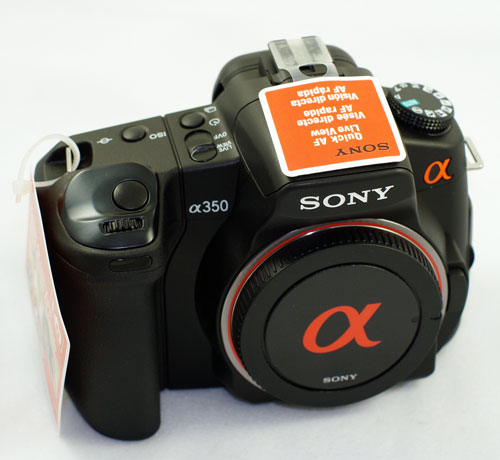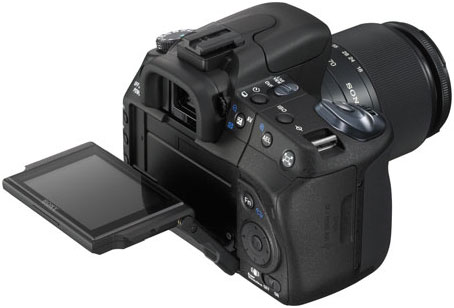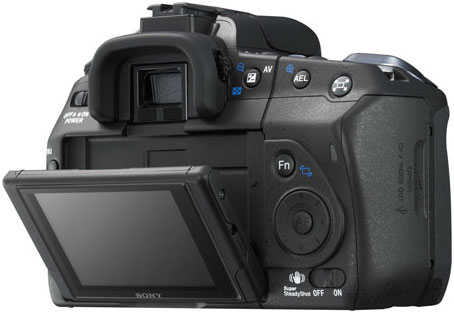Sony A350: Full-Time Live View at 14.2MP
by Wesley Fink on April 3, 2008 3:00 AM EST- Posted in
- Digital Camera
Features and Handling
Sony is used to playing in the large volume retail space where every trick used to gain visibility can result in higher sales.

This is very clear in the packaging theme for Sony DSLR cameras and accessories. No one will miss the bright orange and white (or bright orange and silver) that makes the Sony packages stand out.

The A350 body is on the small side, like the other Sony entry DSLR models, without the extreme smallness that seems to some a problem with the Canon XTi or Nikon D60/D40x. The new Canon XSi is a bit larger than the previous model to address size complaints and accommodate a 3.0" LCD. The Sony A350 is both a little wider (5.25" vs. 5.1") and taller (4.0" vs. 3.8") than the upsized XSi. Minolta pioneered body-integral image stabilization, and the evolved Sony Super Steady Shot is a feature on every Sony DSLR, along with auto sensor cleaning.
The top deck contains a single dial to adjust mode (full-auto, program, shutter-priority, and aperture-priority) and a wide selection of special scene programs such as portrait, sports, night, etc. On the opposite side of the viewfinder hump you will find a mechanical (no power required) Live View/OVF (Optical Viewfinder) switch, timer/drive mode button, and ISO button. The shutter release and shift/adjust dial are on top of the comfortable handgrip.

9-point auto-focus is featured on the A350. The layout and pattern is the same as the A200, A300, and earlier A100 suggesting it is the same AF module. The burst AF speeds on all models also support the conclusion that this is likely the same venerable AF module used in previous Minolta and Sony digital SLRs. Sony claims faster AF in the newest models, and that is likely the result of faster data processing in the supporting data processing modules in the DSLR. The prosumer A700 uses an updated and faster 11-point AF system. The A350 AF system is very competitive in its class and a big step up from the Olympus 510/410/420 and Nikon D60/D40x 3-point AF modules.


While the A350 is a bit larger than the Canon XSi, the LCD is 2.7" instead of the 3.0" LCD featured on the XSi. However, it is the only LCD in its class that is articulated, allowing an upward tilt as far as perpendicular for low-level shots and a down tilt to allow holding the camera above your head for crowd shots. These kinds of shooting situations require a contortionist on the usual DSLR and they are a great benefit for the capable and fast Sony Quick AF Live View. The LCD brightness is adjustable up and down, but it was still a challenge to read info on the LCD in bright sunlight. Perhaps some aftermarket LCD hood will improve LCD viewing.

The rear finds the on-off switch to the left of the viewfinder, which is typical of all the current Sony models. To the right of the viewfinder are the metering pattern/exposure compensation button, AEL (exposure lock)/zoom button, and the unique auto teleconverter. The teleconverter switch just takes advantage of the high-resolution sensor to give you instant 1.4x and 2x crops of the regular image. It does not add or interpolate pixels.
The main part of the a350's back is dominated by the 2.7" tilt screen, and the expected MENU, DISPlay, Delete (Trash Can), and Playback buttons to the left of the screen. To the right is the extremely useful Fn (function) button, which brings up the most commonly used adjustments to allow quick adjustments without searching through menus. The up/down/select multi-controller is used to navigate menus and the screen and a Super Steady Shot on/off switch complete the rear controls.
The sensors at the bottom of the viewfinder are the trademark Minolta "auto-on" when you bring the viewfinder toward your face in OVF mode. There is also a small knurled wheel to adjust viewfinder focus to match your eyesight. This former high-end feature is now making its way into almost all of today's DSLR cameras.
Handling
The A350 is an entry-level camera despite some high-end features like the 14.2MP sensor. As such, it is designed to be easy to use. Ours came out of the package setup at the factory for Live View mode with Super Steady Shot on. In general, Sony made the controls very easy to use and figure out. Sony tells us one complaint from buyers moving from point-and-shoot digital cameras to a digital SLR is that they are often overwhelmed by the controls of the DSLR. Point-and-Shoot users will find the A350 easy to use and familiar right out of the box.
Another editor at AnandTech ordered the A350 from SonyStyle as soon as he saw the specifications in our PMA reporting. He received his A350 last week and commented that the controls on the A350 were extremely easy to figure out and use. He said after 15 minutes he felt like he could figure out most everything on the camera and he was ready to "shoot like a Pro" with the A350. If other new users also find this kind of "instant comfort" with the A350, it will become a big seller.










113 Comments
View All Comments
Wesley Fink - Saturday, April 5, 2008 - link
Can you please post a link to the $30 price for the Sony NPFM500H battery? The battery for the new A700, A350, A300, and A200 is the same, but it is different from the earlier battery for the A100. The earlier A100 battery is both cheaper and available as a cheap generic, unlike the FM500H so far.I just checked and Amazon has a price of $54 with an "Out-of-Stock" for 1 to 2 months. Sony Style is $69.99. If it is now available for $30 ANYWHERE I'm sure a lot of Sony users would appreciate the link.
0roo0roo - Saturday, April 5, 2008 - link
typical sony arrogance. i would not give such a camera a second look because of the battery alone.Wesley Fink - Saturday, April 5, 2008 - link
The battery price was pretty annoying to a pot of posters on Forums and I thought it should definitely be discussed as most buyers don't discover this "gotcha" until after their purchase. As we mentioned, with Sony using the same expensive battery in all their new DSLRs there is some hope for a reasonably priced OEM battery in the future - unless Sony has something in the technology completely tied up with patents.Interestingly chargers for the old A100 battery work fine with the new FM500H. It appears the A100 batteries would work fine in the new cameras if they had the center groove that is on the FM500H. Perhaps some enterprising Asian source will come up with a battery at a decent price that will work in the new Sony cameras.
danddon - Friday, April 4, 2008 - link
I’m sorry, but I just couldn’t resist helping out Mr. Fink with his K20D technology – in particular, the 14.6 megapixel CMOS sensor.Just a few searches on the net uncovered the Pentax marketing material that describes this sensor, as well as a slide from an Asian presentation showing the structure and size of the individual photosites of the sensor.
Unfortunately, this material only proves that my method of calculation of photosite area was correct: the Pentax sensor has a photosite size of 5 microns, with an intersite gap of .13 microns. I said we should ignore this gap, because it is difficult to find the exact dimensions for all sensors in the literature.
I did not calculate the size of the photosites for the K20D sensor, but, for the sake of clarity and completeness:
23.4mm/4672 pixels = 5.009 microns
15.6mm/3104 pixels = 5.026 microns
Please note that this number should really be 5.13 microns, so my calculation is not 100 percent accurate. However, I felt it close enough for the purposes of this review. I will leave it to the reader to be the final judge.
What Mr. Fink was really referring to was the size of the photodiode at each photosite. The photodiode, as we all understand, is the device that actually does the conversion of the incoming photons to electrical energy. And, as we all understand, since it is not yet technically possible to construct a photodiode that covers the entire photosite, a microlens is placed over the top of the photosite assembly to focus the incoming photons onto the active area of the photodiode.
With good engineering, the combination of the structure of the microlens and the size of the photodiode, will result in an approximation of a photodiode that effectively covers the entire photosite. Of course, each manufacturer has their own techniques for optimizing this approximation, and probably much of the engineering could be considered a trade secret.
I tried to avoid all this complication by simply giving Mr. Fink the benefit of the doubt, and assuming in my calculation that the photodiode did, in fact, cover the entire photosite area. I thought this was in keeping with the tenor of the review itself, and subsequent discussions in this forum – keep it simple.
What Pentax claims to have achieved is a photodiode size that is larger than the photodiode size of the Sony A700 12.2 megapixel sensor. This size is measured as being 40 percent of the area of the photosite, which would be 40 percent of 25 or 10 sq. microns. I will give them and Mr. Fink that. However, this does not change the size of the photosite itself, which is: 5 microns.
Finally, Mr. Fink claims early in his response – “… the photosite size for the K20D does not scale as you indicate.”
I can only refer Mr. Fink to the folks at Samsung/Pentax, as well as to at least two other photography sources. These people would say that , in fact, yes - it does. And, I am constrained to point out – as my own calculation suggests.
But, I fear I have gone far, far astray from the original intent of the review, which was to simply look at the crops and determine the comparative noise attributes. Maybe I will try that sometime in the future, but don't hold your breath.
jake123 - Saturday, April 5, 2008 - link
Danddon, I doubt if you even knew the difference between a photodiode and photosite beforehand.But a clarification of terminology is a good thing.
Also, you should just compare the photos as Wesley tells you and judge for yourself.
danddon - Saturday, April 5, 2008 - link
Actually, Jake123, I didn't even know what a digital camera was until I happened upon the AnandTech site. But, I am trying to learn.I have used the instant film cameras on occasion, but only when I could sell enough cans and bottles from my shopping cart to pay for them.
Thank you for your helpful words of advice, and appreciate your patience. I will be comparing those photos as fast as my limited intelligence will allow.
I apologize if my feeble attempt at technology was not appreciated. I hope you weren't too offended.
Wesley Fink - Friday, April 4, 2008 - link
What is your point? The article does not mention photosite size except in passing. Did you really expect an in-depth treatise on the impact of photosite size in the front page discussion Forum of this review? There are many variables that affect the ability of a pixel to respond to light and the size of the pixel is one of them. It is important, but it is not the only variable, as you well know.The K20D and Canon 5D are CMOS sensors and the Sony A350 is CCD. I can point to articles at respected sites in the past who argued that CMOS sensors would always be inferior to CCD. Of course the entire Canon line is now CMOS, and all the new sensor introductions have been CMOS except this Sony 14.2 sensor. Even the A700/D300 is CMOS. Obviously manufacturers found ways to get around the inherent limitations of CMOS sensors. Photosite or pixel size is another inherent limitation.
The images are there for you to decide for yourself. If they aren't controlled enough for your liking you can perhaps find what you seek elsewhere on the web. Thank you for your research and for bringing your findings to my attention.
Barbu - Friday, April 4, 2008 - link
Last time I checked, being a PRO meant that you got your rent, your car and your equipment paid from the photography job. Mr. Fink might try to pose as a PRO, but no professional photographer would go on semi-auto mode in low-light. Really, that sentence looks like a high-school brag and for the real pros it's simply laughable.It's sad to see that the author ran out of valid reasoning and ended up using his fists to defend his... opera.
People, try to get this: even if the article is written in layman's terms, it has no practical value; mistakes over mistakes, and any beginner would make *different* mistakes or sub-optimal settings; the article is simply not relevant *for anybody*, enthusiast, prosumer, amateur or plain beginner.
_____________________________________________________
I'm almost certain of a thing: there would be no more polite replies, so I won't continue this thread. But (as many others will do) I'll have a very critical eye for WF's next articles, and any further error in dSLR testing will be sorely pointed out; the consequence will either be building mistrust in Anandtech (wich is a shame, considering the other very good articles), or -as an alternative- the author will be guided to other... workplace.
So, Mr. Fink: be very careful, you're watched.
Maxington - Saturday, April 5, 2008 - link
I've never seen a post more full of horrific levels of "YOU'RE NOT A PRO PHOTOGRAPHER" snobbery.Ken Rockwell is a pro photographer based on your criteria, and I'm not sure if he even knows how to take a photo in anything but full-auto, jpeg mode. And he reviews cameras!
Deadtrees - Saturday, April 5, 2008 - link
I agree Ken Rockwell doesn't know much yet reviews cameras. That's why he became a joke when it comes to camera reviews. Same mistake is being made right here on Anandtech.Not only that, Ken Rockwell is known for his huge ego. That, too, is quite same with the reviwer here on Anandtech.